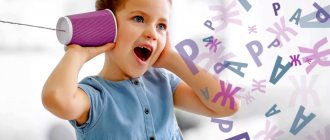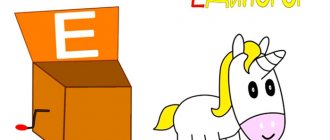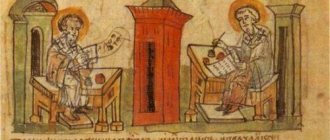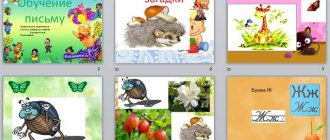Copybook with letter I
Draw worms for the important turkey.
Write block letters I
Color the toys that have the sound I .
Copywriting work with the letters I, Y.
We start with shading according to the pattern, printing lowercase and capital letters. Then we move on to writing capital letters. We are also looking for the letter I among a number of other letters.
Copybook with lowercase and capital letters I, Y.
Writing with capital letter I
Copybook with lowercase letter I
Cursive writing with capital letter Y
Copybook with lowercase letter Y
.
Work is being done on sound-letter analysis, highlighting the vowel I at the beginning, middle and end of words.
Author of the manual: Kosenko Yu. A. “Learning to read and write”
Source: N.Yu. Kostyleva “200 entertaining exercises with letters and sounds for children 5-6 years old”
Speech therapy work in a group on sound begins with articulation and finger exercises, determining the presence of the sound [I] and its place in words. Work continues on the prosodic side of speech, memorizing the graphic image of the letter I, based on all channels of perception (visual, auditory, motor). The work ends with reading the learned letters and writing them.
Vilena Konovalenko “We write and read. Notebook No. 1. Teaching literacy to children of senior preschool age"
Letters I, J for preschoolers (tasks for 2 sheets)
- Task 1. Look carefully at the letters, find similarities and differences.
- Task 2. Find the hidden letters I and Y. Circle them (development of letter gnosis, attention).
- Task 3. The letters are hidden, name them.
- Task 4. Identify the letters in the wrong position.
- Task 5. Color the cubes in which the letters I and Y are written correctly.
- Task 6. The letters are broken, fix them. We need to fill in the missing elements.
- Task 7. There are letters written on the turkeys, find the letters I, Y.
- Task 8. Write the letters I, Y. Trace the dots of capital printed letters.
Source: O.V. Uzorova, E.A. Nefyodova “Tables for teaching reading”
This manual is suitable for teaching reading to very young children. The tasks are simple and accessible. Red text is intended to be read by adults. The exercises are ideal for preparing for school.
Source: Valeria Ivleva “Steps to reading”
Target.Teach children to analyze sounds; introduce the letter Ii; improve children's skills in forming the plural of nouns ending in -i; work with the lexical meaning of words.
Equipment.
Pictures, panels of letters.
Progress of the lesson
1. 1. The teacher tells the story, emphasizing (slightly drawing out) the sound [i].
- I'll tell you about two friends and comrades. The boys I-i-i-gor and Ti-i-i-ma were sitting on the bank of the river-i-i. They played with pebbles. Suddenly, a bird started singing nearby. “E-and-and,” she trilled. Tim said: “This is an oriole.” Igor has never seen this bird. He quietly approached the willow tree. A yellow bird, an oriole, sat on a lower branch and sang its sad song.
2. Articulation of sound.
- How did the oriole sing? (i-i-i) The oriole song is similar to the sound [i]. When pronouncing a sound [and] the lips smile, the teeth are brought together, the air stream flows calmly, the vocal cords vibrate.
Characteristics of sound. The sound [i] is a vowel.
II. 1. - What words with the sound [and] do you remember? (Guiding questions from the teacher are possible) The teacher especially praises children for words in which the sound [and] is at the beginning of the word in an unstressed position, in the middle and at the end of the word.
2. The teacher invites the children to explain the meaning of the words (give a complete answer).
Willow is a plant; oriole is a bird; a hedge is a fence; Igor is a name; a sweater is clothing.
3. — Igor knew how to play the pipe. He took it and played this song: aiu (a-a-a-i-i-i-u-u-u). Tim wanted to repeat it. He realized that the song consisted of three sounds. (The teacher repeats the song, bending his fingers) The first is [a], the second is [and], the third is [y]. Having analyzed this song, Igor performed it correctly.
The teacher invites the children to make out the following songs (how many sounds, what sounds, in what sequence they sound):
iau
(i-i-i-a-a-a-u-u-u);
aui
(a-a-a-u-u-u-i-i-i);
Uia
(u-u-u-i-i-i-a-a-a).
4. Formation of the plural of nouns ending in -i.
— Igor goes to kindergarten and loves it very much. Because his friends and favorite teachers are here. And also because there is a lot of everything here. At home he has one chair, but here there are chairs.
Next, the teacher names the words in the singular, and the children form the plural and draw out the sound [and] at the end of the word.
An approximate set of words: tank, mask, paint, notebook, dog, jacket, car, badge.
III. 1. Getting to know the image of a letter.
The teacher shows a card with a picture of the letter Ii.
The letter is placed on the panel at the address: fifth floor, apartment No. 4.
2. Analytical and synthetic activities.
IV. Game "Jump rope". Goal: training the thumbs.
— Tima has a sister, Ira. She is younger than Tima, but already knows how to jump rope(s). Like this.
Children stand up: palms clenched into fists, arms down, thumbs extended (with tension) - and make circular movements. You need to “twist the jump rope” first in one direction, then in the other. The game is accompanied by a quatrain.
Irochka is not too lazy to jump,
Ira jumps all day long.
Yes, and at night I would jump,
But the jump rope is tired.





